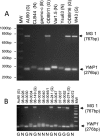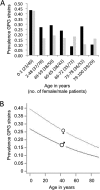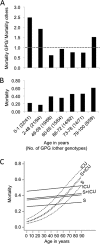Increased mortality in young candidemia patients associated with presence of a Candida albicans general-purpose genotype
- PMID: 21775553
- PMCID: PMC3165600
- DOI: 10.1128/JCM.00941-11
Increased mortality in young candidemia patients associated with presence of a Candida albicans general-purpose genotype
Abstract
The yeast Candida albicans causes life-threatening candidemia. A general-purpose genotype (GPG; corresponds to clade 1) causes more infections than other C. albicans genotypes. To investigate if GPG strains also cause higher mortality, we developed a duplex PCR assay which was 98% accurate in identifying GPG strains in an international collection of strains typed with probe Ca3. We applied the assay to 635 European C. albicans candidemia isolates. Of these, 18% conformed to the GPG genotype, 4% were of a borderline genotype, and 78% were of a non-GPG genotype, broadly consistent with genotype distributions in earlier studies. The prevalence of GPG strains was increased in females and in younger patients, exceeding 40% in infants aged ≤1 year. Logistic regression confirmed sex and age as significant determinants of GPG prevalence. Across the entire patient cohort, there was no difference in mortality for patients infected with GPG strains or other strains (36% versus 37%). However, mortality in patients aged ≤48 years was 33% for infection with GPG strains but only 15% for infection with other strains (z test; P < 0.01). Mortality rates associated with GPG and non-GPG strains were comparable in older patients (39% versus 46%). A logistic regression analysis confirmed the age-dependent impact of genotype on mortality. Thus, GPG strains may be more virulent than other strains in younger patients. Because candidemia is usually caused by endogenous strains, our PCR assay could potentially be used as a risk assessment tool for identifying younger patients most at risk of death from candidemia.
Figures




References
-
- Ashman R. B., et al. 2004. Innate versus adaptive immunity in Candida albicans infection. Immunol. Cell Biol. 82: 196–204 - PubMed
-
- Ausubel F. M., et al. 2006. Current protocols in molecular biology. John Wiley and Sons, Inc., New York, NY
-
- Bliss J. M., Basavegowda K. P., Watson W. J., Sheikh A. U., Ryan R. M. 2008. Vertical and horizontal transmission of Candida albicans in very low birth weight infants using DNA fingerprinting techniques. Pediatr. Infect. Dis. J. 27: 231–235 - PubMed
-
- Dannaoui E Comparison of antifungal MICs for yeasts obtained using the EUCAST method in a reference laboratory and the Etest in nine different hospital laboratories. Clin. Microbiol. Infect. 16: 863–869 - PubMed
Publication types
MeSH terms
LinkOut - more resources
Full Text Sources
Miscellaneous

